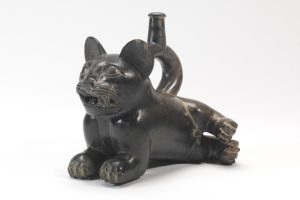
Objects in a new Fowler Museum exhibition demonstrate a deep appreciation for the unity of animals, humans and nature. Pictured: a ceramic vessel from the Moche society in Peru, made between 250 and 450 A.D. Courtesy of Fowler Museum
Piper Bailey | November 25, 2024
On the surface, a new exhibition at the Fowler Museum at UCLA showcases beautiful ceramics and intricate textiles from ancient Peru. But look deeper, says UCLA art history professor Stella Nair, and the works on display reveal much more: the Moche and Nasca communities’ deep appreciation for the unity of animals, humans and nature.
“Their awareness of the ecologies of where they live, the plants, the animals, landscape — these are people who were acutely aware of the entire ecological system in which they lived,” said Nair, who specializes in Indigenous arts of the Americas. “And that animates their entire material world.”
The exhibition, “Taming the Desert: Resilience, Religion, and Ancestors in Ancient Peru,” opened November 10. It presents 34 works by the Moche, who thrived on the north Pacific coast of Peru from the third through the 10th centuries, and the Nasca, who lived in south Peru from 200 B.C. through 600 A.D. (Nair was not involved in organizing the exhibition, which was curated by Luis Muro Ynoñán of Chicago’s Field Museum.)
Objects displayed in the exhibition include painted ceramic vessels, woven garments and religious totems. And although the objects date back a thousand years in some cases, Nair said the work demonstrates that the Moche and Nasca were grappling with some of the same grand questions that arise today when people discuss spirituality, sustainability and the health of our planet.
“These artworks show how they understand their religious beliefs, their relationships with the sacred and how we connect to others,” Nair said.
For example, one piece in the collection is a woven tunic from the Lambayeque society, which thrived in northern Peru in the centuries immediately after the collapse of the Moche culture. The garment’s design, according to exhibition notes, symbolize the community’s religious beliefs and its connection to native medicinal plants.

Stella Nair, who specializes in Indigenous art of the Americas, says the Fowler exhibition demonstrates that the Moche and Nasca were concerned with some of the same grand questions that face humankind today.
And just as many people in 2024 are concerned with climate change, the Moche and Nasca were cognizant of how their surroundings were subject to rapid shifts.
“They were aware of the fragility of the conditions in which they were operating, and that even small changes could be impactful,” Nair said. “They were seafarers, so some of their art depicts sea life and how they survived — or that they could be caught and eaten by whales. They understood that we all pass away, and that there is rebirth. They were understanding of how we humans fit into a much larger pattern.”
Nair said she hopes visitors to the Fowler will also see the exhibition in the context of the contemporary cultures that descended from the ancient Moche and Nasca.
“When we look at objects like this, we recognize that they are not of some mysterious past and lost peoples, but that they’re objects of living communities,” she said. “And that the people living in the Andes today are their descendants, and this is a rich, living tradition.”
“Taming the Desert” continues through March 30, 2025; admission to the Fowler Museum is free.
